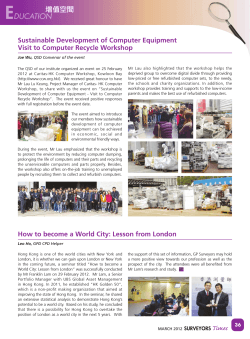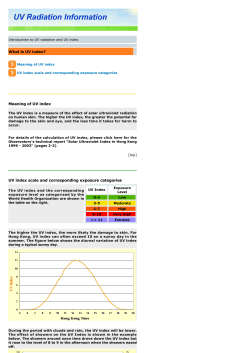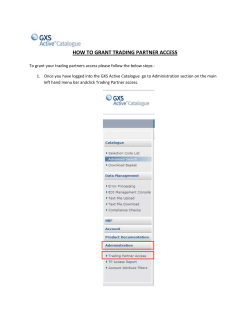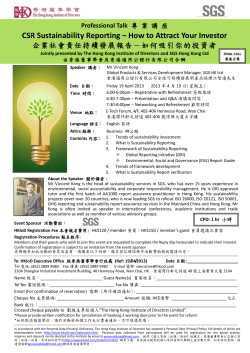
HKEx on Market Integrity Initiatives 4 March 2014
HKEx on Market Integrity Initiatives 4 March 2014 1. What is your plan to introduce circuit breakers to Hong Kong market? We are in a constantly evolving industry, so we have to stay alert continuously for changes that may require new mechanisms to maintain market integrity as well as to maintain our competitiveness versus other exchanges. In recent years, the proliferation of electronic trading has changed the way trading is conducted in almost every market, including our own. Some market participants have told us that they are concerned about the adequacy of the measures to safeguard the Hong Kong market against disorderliness caused by human and machine error. Indeed, this is an area that the International Organisation of Securities Commissions (IOSCO) has asked markets to review, and the Securities and Futures Commission’s (SFC) new electronic trading regulations which became effective early this year push in the same direction. These are the reasons that we are looking at circuit breakers again. We are still at an early stage of our study, and there have been no conclusions as to whether there is indeed a need for some kind of circuit breaker and, if so, when it should be implemented. There are different kinds of circuit breaker models which have been adopted by overseas markets. In the case of some major US and European exchanges, when a circuit breaker is triggered, trading is suspended and there is a switch to auction trading while in some Asian Exchanges (eg, Singapore), trading continues within certain limits before normal trading resumes. If circuit breakers were to be implemented in Hong Kong, we would need to find a model that is suited to our specific needs. Any future proposals on circuit breakers would be put forward for public consultation before there were any decisions on possible implementation. If there’s a proposal and it is supported by the market, we will implement it in an appropriate manner, giving the market time to prepare and adjust. 2. Will you consider introducing Pre-trade Risk Management control measures? If so, why and how will it be implemented? Pre-trade risk management control measures are a subject IOSCO has written about and individual regulators have explored. There are pre-trade risk management control measures at the market participant level as well as the exchange level. Some of our market participants have asked us to include certain automated controls in our trading engines to help prevent trading errors. We are considering those requests. 1 3. Will you consider reintroducing a closing auction? If so, how will it be different from the previous closing auction? We continue to look at potential market microstructure enhancement measures, including a closing auction (CA) to support trading at the market close and improve execution efficiency at the close. A CA was introduced to our market in 2008, but it was suspended after some extreme price movements in certain days and certain securities around the market close. Since the suspension, many brokers and fund managers have repeatedly asked us to reintroduce the CA. They generally recognise that the CA is an internationally proven and effective mechanism for execution at the market’s closing (such as for portfolio rebalancing), helping reduce risks as well as costs, benefiting also indirectly the investing public at large. Hong Kong is the only market of the 23 MSCI Developed Markets without a CA and the market closing in Hong Kong is one of the most volatile among developed markets because of the lack of a CA. We are equally aware that some brokers and investors remain concerned about possible price manipulation in a CA. To this end, any future proposals for a CA must have effective measures that adequately address such concerns. Any proposal to reintroduce the CA on our market and a detailed mechanism will be put forward for public consultation before any decisions are made. We plan to consult the market on CA later this year. 23 MSCI Developed Markets Americas Europe & Middle East Pacific Canada United States Austria Belgium Denmark Finland France Germany Ireland Israel Italy Netherlands Norway Portugal Spain Sweden Switzerland United Kingdom Australia Hong Kong Japan New Zealand Singapore 2 Markett Integrity y Measures s – Globall Benchma arking Cash h Markets Derivattive Marke ets HKE Ex has yett to implem ment mark ket integriity measurres that haave been widely adopted a in n other major mark kets SGX ASX TSE SSE NYSE NDAQ LSE DB TCOM SHFE CME ICE Eurex Liffe Singapore Exchan nge Austra alian Securitiies Exchang e Tokyo o Stock Exchange Shang ghai Stock Exchange New York Y Stock Exchange Nasda aq Londo on Stock Exc change Deutssche Börse Tokyo o Commodity Exchange Shang ghai Futures Exchange Chicago Mercantile Exchange Interco ontinentalEx xchange Eurexx Exchange NYSE E Liffe 3 4. What is the progress on the scripless securities market initiative, which is now known as the move to an uncertificated securities regime? HKEx is part of the project, which is being led by the Government. As the Financial Secretary stated in his budget speech last week, the plan is to introduce the Securities and Futures and Companies Legislation (Uncertificated Securities Market Amendment) Bill in the first half of 2014, of which the objective is to establish a legal framework to allow for the introduction of an uncertificated securities market in Hong Kong. Upon the legislative change, the next steps will be for the SFC, HKEx and the other stakeholders to work out the technical details of the operational model and prepare the relevant subsidiary legislation and Exchange rules which will underpin the new uncertificated securities market. The SFC will then conduct a public consultation on the draft subsidiary legislation in due course. HKEx will continue to work closely with the Government, SFC and others on this project. 5. HKEx has recently introduced Mini-Hang Seng Index and Mini H-shares Index Futures to the After-Hours Futures Trading (AHFT) session. What is your next step in the plan for AHFT? In terms of products, we have obtained regulatory approval to add renminbi (RMB) currency futures – the world’s first deliverable RMB currency futures – to after-hours trading from 7 April this year. On the same day, HKEx will also introduce the fourth calendar quarter to the product’s contract months and add more calendar spreads. We plan to add the CES China 120 Index futures to the AHFT Session this year and will announce the launch dates in due course after ascertaining market readiness. In terms of time coverage, HKEx is assessing the feasibility of extending the AHFT to around midnight in order to cover more of the US trading hours. Such an extension would be subject to market readiness. 6. Do you have any plans to adjust the trading spreads for your securities and derivatives markets? We review our market operations periodically to ensure they remain effective. We reduced some of our minimum trading spreads for securities in 2006, and we narrowed our trading spreads for selected stock option classes in the beginning of this year. We do not have any plans at this time to change any of our trading spreads. 4 7. With the evolving global regulatory standards and a more extensive geographical exposure of the HKEx Group, do you consider it necessary to review and further strengthen your clearing house risk management measures? Over the course of 2011 and 2012, we implemented a clearing house risk management reform, which marked the most crucial and significant reform to HKEx’s risk management regime. HKEx continuously monitors changes in the global and Hong Kong regulatory environment, and prudently manages its operations and risk. We continue to work closely with the relevant authorities to ensure that our clearing house risk management remains robust and we meet appropriate regulatory standards. 5
© Copyright 2025





















